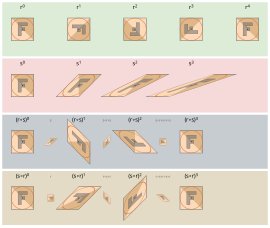
Back مرتبة (نظرية الزمر) Arabic Řád prvku Czech Orden (teoría de grupos) Spanish Ordre (théorie des groupes) French סדר (תורת החבורות) HE 位数 (群論) Japanese 위수 (수학) Korean കോടി (ഗ്രൂപ്പ് സിദ്ധാന്തം) Malayalam Orde (groepentheorie) Dutch Rząd (teoria grup) Polish
This article needs additional citations for verification. (May 2011) |
| Algebraic structure → Group theory Group theory |
|---|
 |

In mathematics, the order of a finite group is the number of its elements. If a group is not finite, one says that its order is infinite. The order of an element of a group (also called period length or period) is the order of the subgroup generated by the element. If the group operation is denoted as a multiplication, the order of an element a of a group, is thus the smallest positive integer m such that am = e, where e denotes the identity element of the group, and am denotes the product of m copies of a. If no such m exists, the order of a is infinite.
The order of a group G is denoted by ord(G) or |G|, and the order of an element a is denoted by ord(a) or |a|, instead of where the brackets denote the generated group.
Lagrange's theorem states that for any subgroup H of a finite group G, the order of the subgroup divides the order of the group; that is, |H| is a divisor of |G|. In particular, the order |a| of any element is a divisor of |G|.
© MMXXIII Rich X Search. We shall prevail. All rights reserved. Rich X Search

